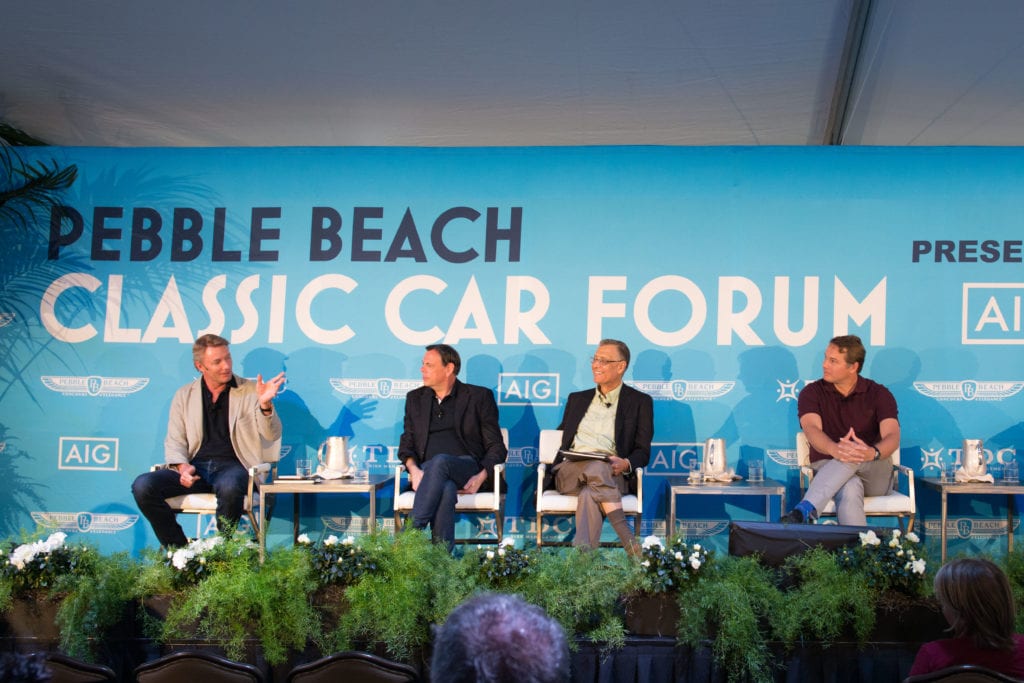Revs Institute Presents: From Here to Autonomy’ at the Pebble Beach Classic Car Forum

Driverless cars won’t kill automotive enthusiasm, but the prospect of them is already changing how car-designers think and how car-collectors develop buying strategies. And if car collectors have anything to fear, it is increased regulation, not autonomy itself.
Those were among the key conclusions from a panel discussion among experts in autonomy and classic cars at the Pebble Beach Concours d’Elegance in Monterey, CA on August 19th, 2017.
“When you design the interior of a car you start with the driver, but we need a different approach if there will be no driver,” said Christopher Svensson, Ford Motor Company’s top global designer for SUVs trucks and commercial vehicles. This fundamental shift in thinking will challenge design teams to create new ideas, he added.
Driverless cars could also free exterior designers to be more expressive, said Chris Urmson, former chief of Google’s driverless-car program who’s now heading his own Silicon Valley startup. With the number of collisions between cars drastically reduced, he explained, safety regulations could be altered, freeing designers to be more expressive and varied in their automotive styling. “There will be a lot more opportunity for beauty,” he remarked.
The panel discussion, the first driverless-car event held at Pebble Beach, was sponsored by Revs Institute, an automotive museum, library and research center based in Naples, FL. Other panelists were Miles Collier, a noted car collector and founder of Revs, and Britain’s Simon Kidston, a car appraiser who develops buying strategies for serious investors. It was moderated by Paul Ingrassia, a Pulitzer Prize-winning journalist and automotive author, and editor-in-chief of Revs.
The consensus amongst the group was that while autonomous vehicles are a near certainty in the coming years, this technology will not impede on enthusiasts’ ability to drive collector cars on public roads in the near future. Rather, autonomy will be a complementary tool to aid all drivers during dreary commutes that make up the vast majority of our time on the road. As Svensson observed, Ford alone has 90 million vehicles on the road, and it will take many decades before the automotive landscape becomes entirely autonomous.
Kidston said the greater threat to enthusiasts in the immediate future is regulation. He cited specifically air-quality rules already being passed in such places as Milan and Rome against the use of older and higher polluting internal combustion vehicles in city centers. He urged enthusiasts to speak out for the historical significance of their hobby.
As autonomy becomes more widespread, Kidston sees the collector-car market becoming increasingly stratified. Great automobiles like vintage Ferrari race cars will always demand top prices, but as the cost of ownership increases, the vast majority of more pedestrian vehicles will hold limited appeal. “The gulf between the best and the rest is getting greater… it’ll be a case of survival of the fittest,” said Kidston.
For Collier, autonomous technology is “congruent with collectors of the future.” Just as hybrid powertrains, a tool for efficiency, have been appropriated by sports-car manufacturers for making faster supercars like the LaFerrari, so too could autonomy “liberate the way we experience driving.” Future cars might have both driving and driverless modes, letting owners choose different modes for different situations. And in driving mode, virtual-reality technology might make routine drives feel more exciting to the driver.
Collier said he would consider adding an early autonomous vehicle to his collection of more than 100 cars at Revs Institute — not because of aesthetic appeal, but because of its technological and historical significance. The panel discussion, he added, was part of Revs’ exploration of how the automobile’s past will relate to its future, and thus “is right in the sweet spot of what we do.”
#######